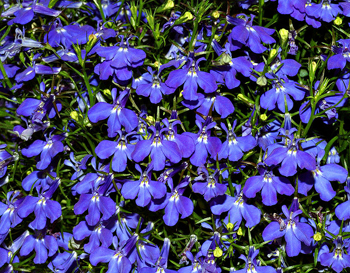Contents:
Common Names | Parts Usually Used | Plant(s) & Culture | Where Found | Medicinal Properties | Biochemical Information
Legends, Myths and Stories | Uses | How Sold | Warning | Resource Links | Bibliography
Scientific Names

- Lobelia inflata L.
- Lobeliaceae
- Bluebell family
Common Names
- Asthma weed
- Bladderpod
- Emetic herb
- Emetic weed
- Eyebright
- Gagroot
- Indian tobacco
- Lobelia herb
- Pan-pien-lien (Chinese name)
- Pokeweed
- Puke weed
- Rag root
- Vomit root
- Vomit wort
- Wild tobacco
Parts Usually Used
Seeds, flowers, and leaves
Back to Top
Description of Plant(s) and Culture

Lobelia is an annual or biennial; the erect, angular stem, growing from 6 inches to 3 feet high, is hairy and contains a milky sap. The thin, light green leaves are alternate, hairy, ovate, and bluntly serrate. Numerous small, two-lipped, pale-blue flowers grow in spike-like racemes, to 1/4 inch; from July to November. The fruit is a two-celled capsule filled with small, brown seeds.
Other varieties: Great lobelia (L. siphilitica) (potentially poisonous); Cardinal flower (L. cardinalis); and Pale-spike lobelia (L. spicata).
Back to Top
Where Found
Found in fields, pastures, meadows, and cultivated fields of the eastern United States, as far west as Arkansas and Nebraska. Related species are found in other parts of the country.
Back to Top
Medicinal Properties
Antispasmodic, diaphoretic, diuretic, emetic, expectorant, nervine, stimulant, sedative
Back to Top
Biochemical Information
Alkaloids, chelidonic acid, isolobeline, lobelic acid, lobeline, selenium, and sulfur.
Back to Top
Legends, Myths and Stories
Lobelia is used in commercial smoking preparations to counteract the desire for tobacco.
The Shoshone Indians used lobelia as an emetic and a laxative.
Back to Top
Uses
In the past, lobelia was used particularly for its antispasmodic qualities to treat asthma and whooping cough, and also to induce vomiting. Externally, the plant can be made into a poultice for bruises, insect bites, worms, croup, epilepsy, sprains, felons, ringworm, erysipelas, and poison ivy irritation. Lobelia is a cough suppressant and relaxant that reduces fever and cold symptoms. Beneficial in the treatment of sore throats, laryngitis, colic, bronchitis, pneumonia, meningitis, hepatitis, pleurisy, tetanus, chorea, convulsions, angina pectoris (chest pains), and epilepsy. Aids in hormone production.
Back to Top
How Sold
Lobeline, one of 14 alkaloids in lobelia, is used in commercial “quit-smoking” lozenges and chewing gum. (Said to appease physical need for nicotine without addictive effects.)
Back to Top
Warning
Although some herbal practitioners have sworn by lobelia as a harmless but effective panacea for what ails man, overdoses of homemade medicinal preparations have resulted in poisoning.
Care should be taken to follow directions in formula or recipe given for medicinal purposes.
Considered toxic, due to its strong emetic, expectorant, and sedative effects. This plant has been, rightly or wrongly, implicated in deaths from improper use as a home remedy.
Use professionally prepared medications under medical supervision only.
Back to Top
Resource Links
LiveStrong.com: Lobelia Herb for Women
University of Maryland Medical Center: Lobelia
Memorial Sloan-Kettering Cancer Center: Lobelia
Bibliography
![]() Back to Eden
Back to Eden, by Jethro Kloss; Back to Eden Publishing Co., Loma Linda, CA 92354, Original copyright 1939, revised edition 1994
![]() The Complete Medicinal Herbal
The Complete Medicinal Herbal, by Penelope Ody, Dorling Kindersley, Inc, 232 Madison Avenue, New York, NY 10016, First American Edition, copyright 1993
![]() Chinese Medicinal Herbs
Chinese Medicinal Herbs, compiled by Shih-Chen Li, Georgetown Press, San Francisco, California, 1973.
![]() The Herb Book
The Herb Book, by John Lust, Bantam Books, 666 Fifth Avenue, New York, NY. copyright 1974.
![]() Eastern/Central Medicinal Plants
Eastern/Central Medicinal Plants, by Steven Foster and James A. Duke., Houghton Mifflin Company, 215 Park Avenue South, New York, NY 10000
![]() Indian Uses of Native Plants
Indian Uses of Native Plants, by Edith Van Allen Murphey, Meyerbooks, publisher, PO Box 427, Glenwood, Illinois 60425, copyright 1958, print 1990
![]() Indian Herbalogy of North America
Indian Herbalogy of North America, by Alma R. Hutchens, Shambala Publications, Inc., Horticultural Hall, 300 Massachusetts Avenue, Boston, Massachusetts 02115, 1973
Herbal Gardening, compiled by The Robison York State Herb Garden, Cornell Plantations, Matthaei Botanical Gardens of the University of Michigan, University of California Botanical Garden, Berkeley., Pantheon Books, Knopf Publishing Group, New York, 1994, first edition
![]() Planetary Herbology
Planetary Herbology, by Michael Tierra, C.A., N.D., O.M.D., Lotus Press, PO Box 325, Twin Lakes. WI 53181., Copyright 1988, published 1992
![]() Prescription for Nutritional Healing, Fifth Edition: A Practical A-to-Z Reference to Drug-Free Remedies Using Vitamins, Minerals, Herbs & Food Supplements
Prescription for Nutritional Healing, Fifth Edition: A Practical A-to-Z Reference to Drug-Free Remedies Using Vitamins, Minerals, Herbs & Food Supplements, by James F. Balch, M.D. and Phyllis A. Balch, C.N.C., Avery Publishing Group, Inc., Garden City Park, NY
![]() Webster’s New World Dictionary
Webster’s New World Dictionary, Third College Edition, Victoria Neufeldt, Editor in Chief, New World Dictionaries: A Division of Simon & Schuster, Inc., 15 Columbus Circle, New York, NY 10023
![]() The Yoga of Herbs: An Ayurvedic Guide to Herbal Medicine
The Yoga of Herbs: An Ayurvedic Guide to Herbal Medicine, by Dr. David Frawley & Dr. Vasant Lad, Lotus Press, Twin Lakes, Wisconsin, Second edition, 1988.
 The Rodale Herb Book: How to Use, Grow, and Buy Nature’s Miracle Plants (An Organic gardening and farming book)
The Rodale Herb Book: How to Use, Grow, and Buy Nature’s Miracle Plants (An Organic gardening and farming book), edited by William H. Hylton, Rodale Press, Inc. Emmaus, PA, 18049., 1974
